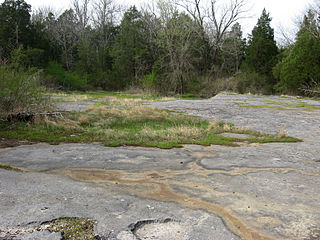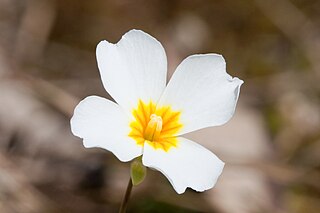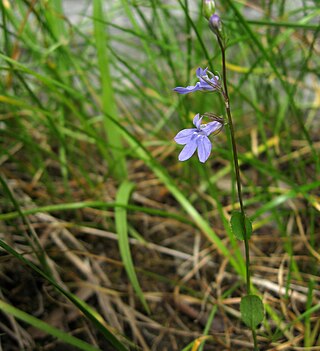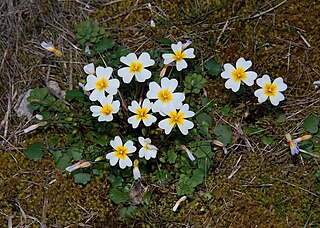The Nashville Basin, also known as the Central Basin, is a term often used to describe the area surrounding Murfreesboro, Tennessee, in which Nashville is located. The Central Basin was caused by an uplifting which produced a dome known as the Nashville Dome. The Nashville Dome is evidenced by the underlying rock strata that all dip downwards away from Nashville. The uplifting of the Nashville Dome fractured overlying strata, making it more easily eroded and thus the "dome" resulted in a "basin". Uplifted strata in the center of a geological dome have higher potential erosive energy than the surrounding strata, because they are physically higher. Erosion thus acts on the uplifted area at a greater rate than on the surrounding flat-lying area, creating a low area, i.e. a basin. This area is more correctly referred to as the "Central Dome" of Tennessee.

A calcareous glade is a type of ecological community that is found in the central Eastern United States. Calcareous glades occur where bedrock such as limestone occurs near or at the surface, and have very shallow and little soil development. Due to the shallow soil and the extreme conditions created by it, trees are often unable to grow in the glades. This creates a habitat that is usually sunny, dry, and hot. Calcareous glade vegetation is more similar to that of a desert habitat than a grassland, being dominated by small spring annuals with occasional geophytic or succulent perennials.

Astragalus bibullatus, the limestone glade milkvetch or Pyne's ground plum, is an endangered species of flowering plant that is endemic to the cedar glades of the central basin of Tennessee in the United States. It is found in only eight populations located within a few kilometers of each other in Rutherford County, Tennessee.

Eriogonum longifolium var. harperi, also known as Harper's buckwheat or Harper's umbrella plant, is a dicot of the family Polygonaceae, found in areas of nutrient-poor shale soils in Alabama, Kentucky and Tennessee. It lives inconspicuously in an immature vegetative stage for four or more years before developing a flowering stalk, then flowers and dies. It is listed as an endangered species by the state of Tennessee. It has eleven small populations in Alabama and five in Tennessee but its survival in Kentucky is uncertain. According to a leading expert, Professor James L. Reveal of the University of Maryland, its Kentucky population has been reportedly extirpated. Its 2006 Alabama Natural Heritage Program ranking was G4T2S1, demonstrating an opinion that it was "critically imperiled" in that state.

Cedars of Lebanon State Park is a state park in Wilson County, Tennessee, in the southeastern United States. It consists of 900 acres (364 ha) situated amidst the 9,420-acre (3,810 ha) Cedars of Lebanon State Forest. The park and forest are approximately 10 miles (16 km) south of Lebanon, Tennessee.

Leavenworthia stylosa is a species of flowering plant in the family Brassicaceae known by the common names cedar gladecress or long-styled gladecress. It is found only in the Central Basin of Tennessee, where it grows in cedar glades, ditches, and low-lying fields.

Symphyotrichum pilosum is a perennial, herbaceous, flowering plant in the Asteraceae family native to central and eastern North America. It is commonly called hairy white oldfield aster, frost aster, white heath aster, heath aster, hairy aster, common old field aster, old field aster, awl aster, nailrod, and steelweed. There are two varieties: Symphyotrichumpilosum var.pilosum, known by the common names previously listed, and Symphyotrichumpilosum var.pringlei, known as Pringle's aster. Both varieties are conservationally secure globally and in most provinces and states where they are native.

The Interior Low Plateaus are a physiographic region in eastern United States. It consists of a diverse landscape that extends from north Alabama across central Tennessee and Kentucky into southern Illinois, Indiana, and Ohio. Its natural communities are a matrix of temperate forests, woodlands, and prairies.

Leavenworthia is a genus of flowering plants in the family Brassicaceae. It includes about eight species native to the southern and southeastern United States. They are known generally as gladecresses.

Viola egglestonii, commonly known as glade violet, is a species herbaceous plant in the violet family. It is native to a small area of eastern North America, only being found in limestone cedar glades of the Interior Low Plateau and Ridge and Valley ecoregions of Alabama, Georgia, Indiana, Kentucky, and Tennessee.

Pediomelum subacaule is a species of flowering plant in the legume family known by the common names Nashville breadroot and whiterim scurfpea. It is native to a small area of Eastern North America, only being found in limestone cedar glades of the Interior Low Plateau and Ridge and Valley ecoregions of Alabama, Georgia, and Tennessee.
Leavenworthia crassa is a species of flowering plant in the mustard family, Brassicaceae, known commonly as the fleshy-fruit gladecress. It is endemic to Alabama in the United States, where it occurs in only two counties. It is "likely one of the most imperiled plant species in the Southeast," and the United States Fish and Wildlife Service issued a final rule listing it as an endangered species in 2014.

Leavenworthia uniflora, called Michaux's gladecress or one-flowered gladecress, is a plant species native to the southeastern and Midwestern parts of the United States. It is reported from northwestern Georgia, northern Alabama, Tennessee, northern Arkansas, southern Missouri, Kentucky, southeastern Indiana, southwestern Ohio, and northwestern Virginia. It grows in open, sun-lit locations at elevations less than 500 meters.

Lobelia gattingeri is a species of flowering plant in the bellflower family commonly called Gattinger's lobelia. It is endemic to calcareous cedar glades and barrens. It has a small range, native only to middle Tennessee, northern Alabama, and one site in the Pennyroyal Plain of Kentucky.

Clinopodium glabellum, the glade calamint, is a species of flowering plant in the mint family. It is native to the Nashville Basin of Tennessee, the Bluegrass Region of Kentucky, and two counties in Alabama. Within this range, it is found only on wet cedar glades and in seeps along limestone creekbeds. Due to its narrow range and specific habitat requirements, this species is considered vulnerable.

Leavenworthia torulosa, the necklace gladecress, is a species of plant in the mustard family. It is native to the eastern United States where it is only found near limestone cedar glades of Alabama, Georgia, Kentucky, and Tennessee. It is considered rare in all states it is found except Tennessee, where it is common in the Nashville Basin due to the abundance of available habitat.

Iris lortetii is a species in the genus Iris. It has straight grey-green leaves, a 30–50 cm tall stem, and large showy flowers in late spring or mid-summer that come in shades of pink, from white, lilac, pale lavender and grey-purple. It is veined and dotted pink or maroon. It has a signal patch that is deep maroon and a sparse and brown, purple-brown or reddish beard.

Symphyotrichum kentuckiense is a rare species of flowering plant in the Asteraceae family and is commonly known as Kentucky aster, Price's aster, Miss Price's aster, Sadie's aster, or lavender oldfield aster. It is a perennial, herbaceous plant that is endemic to broken limestone cedar glades and roadsides in Alabama, Georgia, Kentucky, and Tennessee. It blooms from August through October, reaches heights between 30 centimeters and 100 cm (3.3 ft), and has green to reddish-brown stems. It is a nearly hairless plant with blue to blue-violet ray florets.
Leavenworthia exigua var. laciniata, the Kentucky glade cress, is a threatened variety of flowering annual plant in the mustard family endemic to a small area in the southern outskirts of Louisville, Kentucky. The taxon is listed as threatened by the U.S. Fish and Wildlife Service. The federal government designated 2,053 acres as critical habitat for Kentucky glade cress. Critical habitat for the species in Kentucky's Bullitt and Jefferson counties is threatened by developers, including a proposed natural gas pipeline from Louisville Gas & Electric. A campaign to protect the Kentucky glade cress exists.

Leavenworthia alabamica is a species of flowering plant in the family Brassicaceae. It is commonly known as Alabama gladecress. It is endemic to Alabama.
















